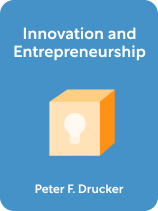

This article is an excerpt from the Shortform book guide to "Innovation and Entrepreneurship" by Peter F. Drucker. Shortform has the world's best summaries and analyses of books you should be reading.
Like this article? Sign up for a free trial here.
What are the most insightful Innovation and Entrepreneurship quotes? How does Peter F. Drucker define an entrepreneur?
In Innovation and Entrepreneurship, Peter F. Drucker debunks the popular stereotype that innovators and entrepreneurs are risk-taking geniuses who invent based on random insights. Instead, Drucker says innovation is a deliberate and methodical study to locate opportunities to improve every aspect of business and life.
Below, we’ll look at a few Innovation and Entrepreneurship quotes that stand out as the best of the best.
Quotes From Innovation and Entrepreneurship
All business methods, technologies, and consumer products grow obsolete and are replaced by something new. Innovation is the process of discovering those new ways of living, working, and doing business, and entrepreneurs are the people who work to bring the future into being. In Innovation and Entrepreneurship, Peter F. Drucker describes innovation as a methodical process to find ways to improve every aspect of business and life.
Let’s explore four different Innovation and Entrepreneurship quotes that embody Drucker’s ideas.
“This defines entrepreneur and entrepreneurship – the entrepreneur always searches for change, responds to it, and exploits it as an opportunity.”
Entrepreneurship and innovation are buzzwords used so often that their true meanings have eroded. Drucker argues that entrepreneurship requires more than simply starting a new business and that innovation takes many shapes beyond inventing new products or techniques. We’ll begin by looking at Drucker’s definitions of innovation and entrepreneurship and how businesses can retool themselves to be more entrepreneurial.
Drucker writes that entrepreneurship is the act of creating new markets and new customers. An entrepreneur brings about change by introducing novel products, services, or business models that disrupt the status quo. This ability isn’t limited to small startups—even large corporations can be entrepreneurs. Likewise, entrepreneurship isn’t confined to the business world—nonprofits can also introduce new ideas and challenge the traditional ways they operate. At its core, entrepreneurship is a mindset that embraces change as a normal and necessary force in society, rather than something to be feared or ignored.
Going hand-in-hand with entrepreneurship, innovation is the tool that entrepreneurs use to create value and drive progress. Drucker explains that innovation involves either changing something that wasn’t a resource into a resource, or changing the way an existing resource is used in a way that increases its value. Innovation isn’t limited to technological advancements—it can also manifest as new social institutions or ways of doing business. Successful innovators identify and leverage emerging trends and opportunities before others. Rather than creating those changes from scratch, most innovators capitalize on existing shifts in society and the market, which they leverage to introduce novel products and solutions.
“And it is change that always provides the opportunity for the new and different. Systematic innovation therefore consists in the purposeful and organized search for changes, and in the systematic analysis of the opportunities such changes might offer for economic or social innovation.”
Entrepreneurs should always watch for changes in a market or industry. Drucker explains that when the basic elements of a market start to shift, larger companies that are set in their ways often struggle to adapt, creating an opening for creative thinkers. This is especially true when industries experience rapid growth, which usually signals an impending structural shift in that industry as a whole. For instance, the auto industry’s rapid expansion in the 20th century gave birth to the “Big Three” US automakers—Ford, GM, and Chrysler. However, with demand still on the rise in the turbulent 1960s and ’70s, the Big Three failed to adapt soon enough, opening the door for foreign automakers to introduce less costly and more fuel-efficient cars.
Demographic shifts also pave the way for innovation, since they provide a broad indication of who will be spending money and on what. Fluctuations in the population’s average age or education level can give you a glimpse into the future pool of consumers. Drucker writes that contrary to what some business leaders believe, these changes don’t always occur slowly—in the 20th century, demographic changes happened quickly, such as the famous post-World War II “baby boom.” The key lies in interpreting how and when these changes will affect consumer behavior. By keeping an eye out for major demographic shifts, you can design new products and services for markets as they emerge.
“Innovations had better be capable of being started small, requiring at first little money, few people, and only a small and limited market. Otherwise, there is not enough time to make the adjustments and changes that are almost always needed for an innovation to succeed. Initially innovations rarely are more than ‘almost right’. The necessary changes can be made only if the scale is small and the requirements for people and money fairly modest.”
As opposed to making a big splash in the general market, Drucker highlights an alternate approach—to dominate a small, specific niche within a larger process or market in a way that renders competition impractical. By creating an innovation or providing a specialized skill that’s integral to another product or process, you effectively make your business indispensable. As long as the market is limited in size, potential competitors can only reduce prices at the expense of their own profits. These niches are rare and can only be discovered through dedicated research, and while they provide security, niche markets come with downsides, such as limited room for growth and a total dependence between your business and the larger market you serve.
One such business that occupied a narrow niche was the Pullman Company that dominated the market for railcar sleeper services in the United States for decades. Pullman designed, built, and owned the sleeper cars that were then leased to railroads, and it also hired and managed the porters and attendants that provided customer service onboard the trains. Because it would have been too expensive for a rail company to provide all of Pullman’s services separately, they had little choice but to use Pullman cars and staff for their sleeper car operations.
“Thus the unexpected success is not just an opportunity for innovation; it demands innovation. It forces us to ask, What basic changes are now appropriate for this organization in the way it defines its business? Its technology? Its markets? If these questions are faced up to, then the unexpected success is likely to open up the most rewarding and least risky of all innovative opportunities.”
Innovation often comes wrapped in unexpected packages, such as unforeseen successes or failures. Companies must be ready to respond to these unanticipated events, as they can offer valuable insights into potential growth opportunities. Surprise successes present a challenge because they often undermine a business’s basic assumptions or else go completely unnoticed. Surprise failures are similarly disruptive, as they sometimes necessitate organizational changes, a shift in resources, or new business assumptions altogether.
Drucker writes that the clearest sign of a potential innovation is unexpected business success. However, capitalizing on a surprise triumph can be a challenge for a business that’s deeply entrenched in its traditional ways of operating. This is especially true if the success undermines the core product or service upon which the company has built its identity. For instance, if a prestige winery makes an unexpectedly large number of sales through a discount liquor chain, this might shatter its self-image as a business that caters to high-end, luxury tastes. However, if a business can embrace an open and humble perspective, it can transform surprise success into a catalyst for unlocking new avenues for growth.
Surprise successes slip under the radar when organizations aren’t actively looking. Drucker warns that shifts in customer behavior and emerging market trends can go unnoticed if they fall outside the company’s established reporting mechanisms, which can prove disastrous if competitors take advantage of these opportunities first. To avoid missing out, leaders must continuously watch for signs of unanticipated success. When surprises occur, management must honestly assess what organizational changes may need to happen to nurture and expand on these wins, allocating top talent and resources if needed.

———End of Preview———
Like what you just read? Read the rest of the world's best book summary and analysis of Peter F. Drucker's "Innovation and Entrepreneurship" at Shortform.
Here's what you'll find in our full Innovation and Entrepreneurship summary:
- Peter F. Drucker’s template for structuring an entrepreneurial organization
- Strategies for bringing innovations to the market
- How to manage entrepreneurial startups






